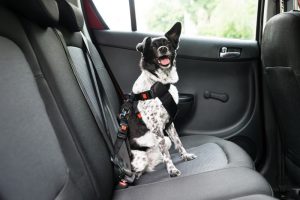
Dog guardians can help their pets build positive associations with car travel, and ensure they get them used to whatever equipment they will be using to keep them safe © Can Stock Photo / AndreyPopov
Just recently I’ve helped several owners with dogs who’ve developed real aversions to car travel.
Definitely this hasn’t been helped by not going places in the car during lockdown. Maybe these dogs haven’t set foot in the car at all but now they’re expected to just jump right in. But what if they are not comfortable to do so?
What can we do to set our dogs up for easy, trouble free car travel?
Happy car experiences should be part of the ‘habituation collage’ you put together as a new puppy owner. This is when you jot down everything your puppy will come to experience as an adult dog. My advice is to start as soon as you can.
At the same time, don’t rush it – and always make sure you proceed at your puppy’s pace. Stop immediately if you notice signs of anxiety or distress.
- Start with just popping your pup inside the car with all doors open and treating it a little like a play pen on your driveway. If you have the doors or trunk closed, the space can be claustrophobic, so you want a nice open, breezy space.Take a few toys in there and make it a fun, inviting, happy space.Progress to switching on the car engine to help your pup acclimatize to the sound. (You could also use some sound ‘desensitization’ downloads on your phone or tablet).
Check your local laws. In the UK, your dog must be restrained safely within the car, so choose where he’s going to be: on the backseat with a car harness and seatbelt, in the trunk (if you have a saloon or SUV), safely secured behind a dog guard or in a crate (and not simply sitting on your knee in the front seat).
Now is the time to start getting your dog used to whatever equipment you plan to use.
- Once your dog is relaxed in the car and with the sound of the engine, start to take him on very short journeys, all with a positive ending. Perhaps a short walk, or a game with friends.
- Avoid having your dog eat or drink just before a journey so you don’t risk seeing the contents again very soon! Some dogs can also become nauseous, especially young puppies, so not feeding prior to travel is important.If your dog is nauseous, it can become an issue if he begins to associate feeling unwell with car travel. You may wish to consult your vet for assistance with this.
- Think about your dog during travel.If you’re fond of playing loud music, ideally turn it down a notch. Heavy bass can be especially hard on dog’s ears.Ensure you have a steady air flow through the car and if you are unable to safely open back windows (a very small amount, so the dog cannot get any part of his face through the gap), portable travel fans can be really useful placed in the rear on long journeys.
Never allow your dog to poke his head fully out of the car window. Not only is this incredibly dangerous when vehicles pass close by, but it increases the risk of eye irritation.
- In my experience, dogs travel better when they are properly restrained (as they legally should be), have the ability to balance, are not slipping on surfaces, are not too hot, and have air flow.
Depending on the individual, some dogs travel more calmly when they cannot see (for example, the crate can be covered) while others are desperate to see where they are going.
Take care to corner and brake slowly as hurried driving and negative experiences will easily put a dog off balance and may put him off from re-entering the car.
- If your dog is reluctant to enter the car in the first place, consider whether it is easily accessible. Trunks can be tricky to get into if they are high up, and jumping is obviously harder for older dogs and dogs with mobility issues. There are lots of ramps and steps now available to ensure your dog does not hurt himself or strain joints/muscles when jumping in and out of a car.
Taking a few simple steps either from puppyhood or as soon as you adopt your dog can make so much difference to avoiding travel issues later on in life. And even if you didn’t do this, it’s never too late to start!
